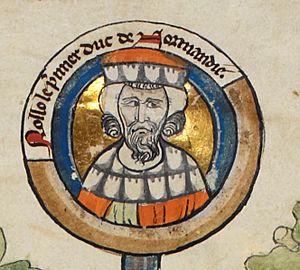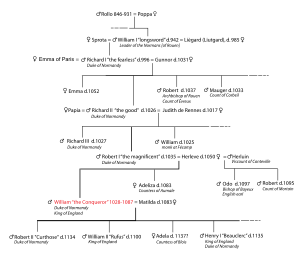Rollo facts for kids
Quick facts for kids Rollo |
|
|---|---|

Rollo as depicted in the 13th century
|
|
| Count of Rouen | |
| Reign | 911–928 |
| Successor | William Longsword |
| Born | c. 835/870 Scandinavia |
| Died | 928/933 Normandy |
| Burial | Rouen Cathedral |
| Spouse |
|
| Issue more |
|
| House | Normandy (founder) |
| Religion |
|
Rollo (also known as Rolloun or Rollon) was a famous Viking leader. He became the first ruler of Normandy, a region in northern France today. He was known as the Count of Rouen.
Rollo was a strong warrior among the Norsemen. These Norsemen had managed to settle permanently in the lower Seine river valley. After a big fight called the Siege of Chartres in 911, King Charles the Simple of West Francia made a deal with Rollo.
The king gave Rollo and his people land between the mouth of the Seine and the city of Rouen. In return, Rollo agreed to stop his raids, promise loyalty to the king, become a Christian, and help protect the Seine river from other Viking attackers.
Rollo's name first appeared as the leader of these Viking settlers in a document from 918. He ruled Normandy until at least 928. His son, William Longsword, took over after him. Rollo founded the Duchy of Normandy.
Rollo's family and his followers mixed with the local French people. They became known as the "Normans". Later, the Normans conquered England and parts of southern Italy and Sicily. Rollo's descendants ruled England, much of Ireland, Sicily, and Antioch from the 11th to the 13th centuries. They left a lasting mark on European history.
Contents
Who was Rollo and where did he come from?
Rollo was born in the mid-800s. He was most likely from Scandinavia, but we are not sure if he was Danish or Norwegian. One of the first historical events linked to Rollo is his part in the siege of Paris in 885–886. However, the Vikings were stopped by Odo of France.
Old stories disagree about whether Rollo's family was from Norway or Denmark. This might be because people at the time used words like "Vikings," "Northmen," "Swedes," "Danes," and "Norwegians" to mean similar things.
A writer named Dudo of Saint-Quentin wrote about Rollo in the late 900s. He said Rollo "the Dane" was from a place called Dacia. Dudo's book was asked for by Rollo's grandson, Richard I. So, it might have some bias, meaning it could favor Rollo's family.
Later, other historians like Goffredo Malaterra and William of Malmesbury said Rollo was from Norway. They wrote that he sailed from Norway to the Christian coast.
Some Icelandic stories from the 1200s say Rollo was the same person as Hrólf the Walker. He was called "the Walker" because he was so big that no horse could carry him. These stories claim Hrólf was from Møre in western Norway. His parents were a Norwegian jarl (a type of count) named Rognvald Eysteinsson and a noblewoman named Hildr Hrólfsdóttir.
Rollo's Life and Rule
A writer named Flodoard said that Rollo took over Rouen in 876. This is supported by other records. Later, Robert of the Breton March fought against the Vikings and gave them "certain coastal provinces."
Dudo's story says Rollo became friends with a king in England named Alstem. This king is now thought to be Guthrum, a Danish leader who was baptized by Alfred the Great.
Dudo also wrote that Rollo took a woman named Poppa of Bayeux from Bayeux. He married her, and she gave birth to his son and heir, William Longsword. Her family background is not clear, and some historians think it might have been made up to make her son's family line seem more important.
In 911, Robert I of France defeated another group of Viking warriors in Chartres. This win helped lead to Rollo's baptism and his settlement in Normandy. Rollo agreed to be baptized and help the king defend the kingdom. As was the custom, Rollo took the baptismal name Robert, named after his godfather Robert I.
As part of the agreement, Rollo was supposed to marry Gisela of France, King Charles's daughter. Gisela might have been very young at the time, possibly only five years old. This kind of marriage agreement for children was common back then for diplomatic reasons.
The first official record of Rollo is from 918. It's a document from King Charles III that mentions an earlier grant to "the Normans of the Seine," meaning "Rollo and his friends." This was for "the protection of the kingdom." Dudo said this agreement happened in 911 at Saint-Clair-sur-Epte.
Dudo tells a funny story about Rollo's promise of loyalty to King Charles III. The bishops told Rollo to kiss the king's foot to show his loyalty. Rollo refused, saying he would never kneel to any man. Instead, he told one of his warriors to do it. The warrior lifted the king's foot to his mouth while the king was still standing. This made the king fall backward, which made everyone around them laugh.
After promising loyalty, Rollo divided the lands between the rivers Epte and Risle among his leaders. He settled in Rouen, which became the main city of his new territory.
Rollo died sometime between 928 and 933. His son, William Longsword, took over from him.
Rollo's Family and Legacy

Rollo's son, William Longsword, and his grandson, Richard the Fearless, made the Duchy of Normandy a very strong and important region in West Francia. Rollo's family and his men mixed with the local French people and their Christian culture. They became known as the Normans, and the region was named Normandy after them.
Rollo is the great-great-great-grandfather of William the Conqueror. William the Conqueror started the House of Normandy in England. The British Royal Family today is not directly related to Rollo through the male line. However, the House of Plantagenet had Norman influence because Empress Matilda, the mother of Henry II of England, was the daughter of the Norman king Henry I of England.
Scientists tried to study the bones of Rollo's grandson and great-grandson in 2011 to learn about Rollo's origins. However, the bones they found were much older than Rollo's time, so they were not related to him.
Rollo's family continued to rule Normandy for a long time. Many French kings from the Capetian dynasty were descendants of Rollo through different family lines. Rollo's family was able to stay in power because they were strong in battle. Also, the Frankish nobles fought among themselves, which made them weaker and unable to stop the Vikings from settling in Rouen.
Rollo in Stories and Games
Rollo has appeared in different stories and games:
- He is the subject of a 17th-century play called Rollo Duke of Normandy.
- A character inspired by Rollo is Ragnar Lothbrok's brother in the TV show Vikings. This character's story is different from the real Rollo's life.
- Rollo is also a character in the video game Assassin's Creed Valhalla.
Images for kids
-
Rollo's grave at the Cathedral of Rouen
See also
 In Spanish: Hrolf Ganger para niños
In Spanish: Hrolf Ganger para niños



